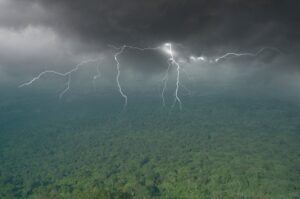A mysterious, invisible force of nature lurks in the upper regions of our atmosphere. Jet streams are strings of strong wind currents formed by differences in temperature, and they can move at staggering speeds. Unbeknownst to many, jet streams have a great effect on our daily lives, from weather patterns to our travel plans.
The discovery
A Japanese meteorologist named Wasaburo Oishi first discovered a jet stream in the 1920s. An expert in meteorology, Oishi founded Japan’s first upper-air observatory and focused his research on the happenings of the upper atmosphere. At the forefront of his field, Oishi long held suspicions of a strong and extremely fast-moving air current that flowed from east to west.
After launching numerous weather balloons near Mount Fuji, he proved his theory right; this fast-flowing river of high-altitude currents rapidly sped his balloons east. In a book chronicling his discovery, he described it as “a strong wind in the upper air.” Some of these balloons ended up in the United States.
Yet this was not the first time someone had noticed the phenomenon. When Oishi heard of similar observations in other parts of the world, he determined that a continuous stream of fast-moving air encircled the Earth.
The phenomenon was likely first noticed in 1883 when the Krakatoa volcano erupted. The eruption sent hundreds of tons of volcanic ash and toxic fumes 80km into the air. These got caught in the jet stream and spread around the planet, plunging it into a volcanic winter. The planet’s temperature dropped 0.4°C the year after the eruption. Scientists also suspect the jet stream is responsible for the devastating 1930s Dust Bowl.

A diagram of the jet streams. Photo: National Weather Service
Largely unknown outside of Japan
However, for several years, Oishi’s discovery went mostly unnoticed. This was partly Oishi’s fault, an enthusiastic Esperanto speaker (a language created in 1887 to be a universal second language) he decided to publish his work in the obscure language. According to the Exo-Weather Report, “Oishi’s work fell victim to his desire to promote Esperanto, and unwisely Oishi published his many studies in this artificial language. Unfortunately, few shared his passion for Esperanto and his work languished…”
Though his discovery didn’t create waves abroad, Japan took advantage of the jet stream to launch attacks on America during World War II. One high-profile example was the bombing of Oregon in 1945. A balloon launched into the jet stream carried explosives that killed several civilians.
With Oishi’s findings little known outside of Japan, a jet stream was “discovered” again in 1934. American pilot Wiley Post was in the middle of a solo flight around the world when he caught on to the presence of a fast-moving stream of air.
Then, in 1939, a German meteorologist stole the limelight by coining the term “jet stream”, from the German word “strahlströmung”, based on various pilots’ experiences and observations. While initially thought to be one jet stream, further research found several at varying latitudes.
The mechanics
The Earth’s jet streams are in the tropopause, the boundary between the Earth’s troposphere and stratosphere. The currents supposedly meander like a river and the winds are extremely turbulent. They are so powerful that they can increase the speed of commercial flights, particularly if they travel from west to east. A pilot can reduce their flight time and save fuel. However, flights using the jet stream can experience lots of turbulence.
There are two types of jet stream: polar and subtropical. The polar jet streams form at the polar front, a region at which the atmospheric circulation cells, Ferrell and Polar, meet. These streams travel at up to 400kmph and are strongest during the winter months when the disparity in temperature is at its most extreme.
Jet streams are the result of a difference in air temperature when warm air meets cold air, but the rotation of our planet plays a key role too. The National Weather Service describes it as such: “The motion of the air is not directly north and south but is affected by the momentum the air has as it moves away from the equator. The reason has to do with momentum and how fast a location on or above the Earth moves relative to the Earth’s axis.”
Relation to climate change
Recent data suggests that jet streams play a significant role in current changes to our climate and warming temperatures. The jet streams seem to create heat waves when they form a U-bend, according to the World Economic Forum. Like a ripple effect, this further impacts the weather, resulting in extreme weather conditions. Oxford professor Tim Woollings calls this stuck period “blocking.”

Jupiter’s jet streams. Photo: NASA
Other jet streams in the Solar System?
Jet streams aren’t unique to Earth. You can find them on the gas giants Jupiter, Saturn, Uranus, and Neptune. Jupiter, for example, has many jet streams which manifest in its characteristic multicolored stripes. The storms on these planets are responsible for the formation of over 20 jet streams on each and the streams can reach up to 1,440km per hour.






